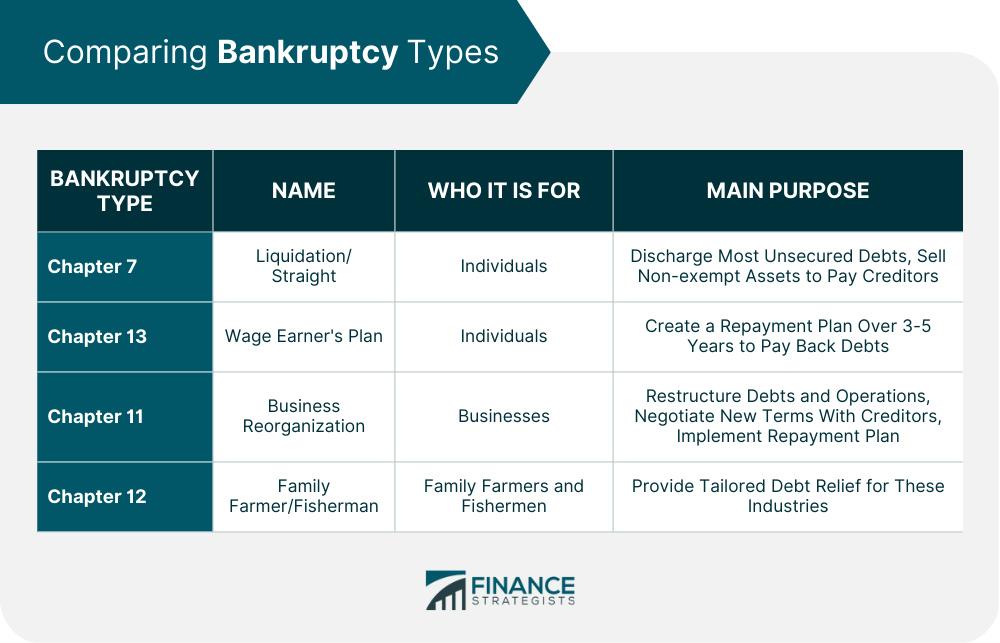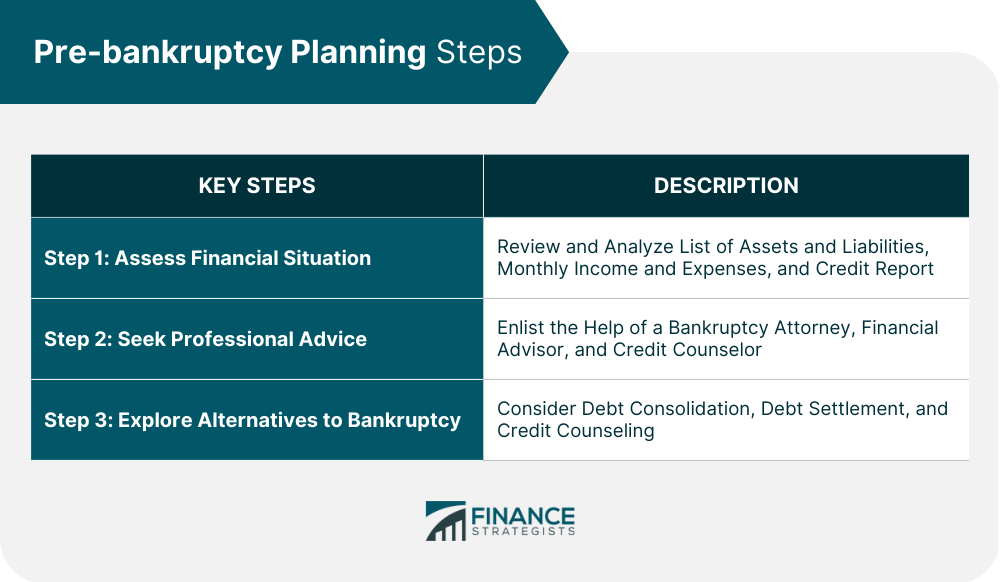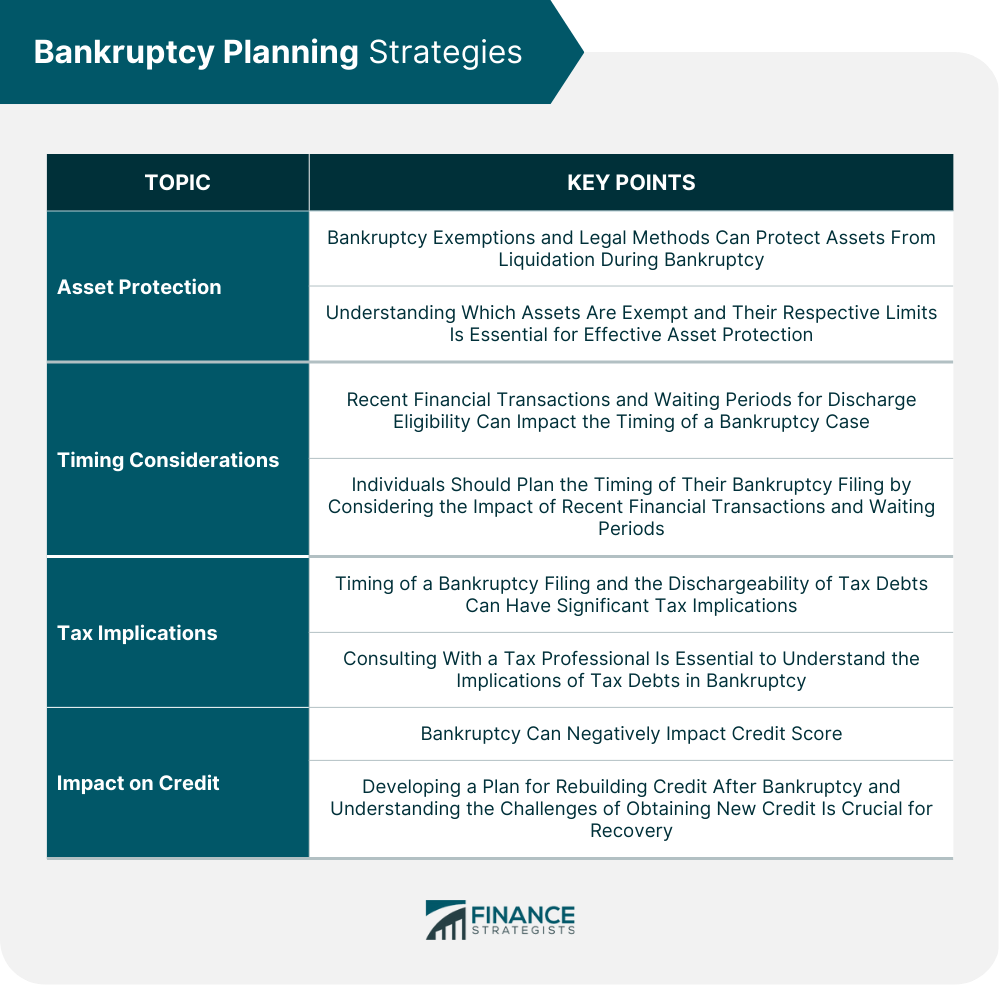Bankruptcy is a legal process that provides individuals or businesses relief from their debts. The purpose of bankruptcy is to help those overwhelmed by financial obligations to eliminate or repay their debts under the protection of the federal bankruptcy court. Bankruptcy planning is an essential step for individuals or businesses considering filing for bankruptcy. It involves evaluating one's financial situation, understanding the available bankruptcy options, and strategizing to maximize the benefits while minimizing the negative consequences of filing for bankruptcy. Understanding the different bankruptcy options and their implications is crucial for making an informed decision. Proper planning can help individuals and businesses navigate the bankruptcy process effectively, protect their assets, and rebuild their financial future. Chapter 7 bankruptcy, also known as "liquidation" or "straight" bankruptcy, allows individuals to discharge most of their unsecured debts, such as credit card bills and medical expenses. In exchange, the debtor may have to sell some of their non-exempt assets to pay off their creditors. Chapter 13 bankruptcy, often called a "wage earner's plan," allows individuals with regular income to create a repayment plan to pay back all or part of their debts over a period of three to five years. Chapter 11 bankruptcy is designed for businesses that need to reorganize their debts and restructure their operations while continuing to operate. This type of bankruptcy allows the debtor to negotiate new terms with creditors and implement a plan to repay the debts. Chapter 12 bankruptcy provides debt relief to family farmers and fishermen who are experiencing financial distress. This type of bankruptcy allows for a debt repayment plan tailored to the unique needs of these industries. Before considering bankruptcy, individuals and businesses should compile a comprehensive list of their assets and liabilities to evaluate their financial standing. Analyze monthly income and expenses to determine the feasibility of repaying debts through a repayment plan or if liquidation is necessary. Reviewing one's credit report can help identify any inaccuracies or discrepancies that may affect the bankruptcy process. Consulting a bankruptcy attorney can provide valuable insights into the legal process, eligibility, and potential outcomes of filing for bankruptcy. A financial advisor can help assess one's financial situation and recommend alternatives to bankruptcy, if applicable. Credit counseling can offer guidance on managing debts, improving credit, and creating a plan for long-term financial stability. Debt consolidation combines multiple debts into a single loan with a lower interest rate, simplifying repayment and potentially reducing the overall debt burden. Debt settlement involves negotiating with creditors to reduce the amount owed, potentially avoiding bankruptcy. Credit counseling agencies can help create personalized debt management plans, offering an alternative to bankruptcy. Bankruptcy exemptions protect certain assets from liquidation during the bankruptcy process. Understanding which assets are exempt and their respective limits can help individuals plan effectively to protect their property. There are legal methods, such as establishing trusts or converting non-exempt assets into exempt assets, to protect one's property during bankruptcy. Consult a bankruptcy attorney to determine the best strategies for asset protection. Recent financial transactions, such as asset transfers or large debt repayments, can impact the bankruptcy process. Understanding the implications of these transactions can help individuals plan the timing of their bankruptcy filing. There are waiting periods between bankruptcy filings and discharges, which may affect the timing of a new bankruptcy case. The timing of a bankruptcy filing can impact the dischargeability of tax debts. Consulting with a tax professional is essential to understand these implications. Certain tax debts, such as income tax debts, can be discharged in bankruptcy, while others may not be eligible for discharge. Understanding the dischargeability of tax debts is crucial for proper planning. Bankruptcy can have a significant negative impact on one's credit score. Developing a plan for rebuilding credit after bankruptcy is essential for financial recovery. Understanding the challenges of obtaining new credit during and after bankruptcy can help individuals plan for their financial future and set realistic expectations. Before filing for bankruptcy, individuals must complete credit counseling with an approved agency to ensure they understand the implications of bankruptcy and explore potential alternatives. The means test is used to determine eligibility for Chapter 7 bankruptcy by comparing an individual's income and expenses to the state median income and allowed expenses. Bankruptcy petitions require specific forms and documentation, such as schedules detailing assets, liabilities, income, and expenses. Properly completing and submitting these forms is crucial for a successful bankruptcy case. There are filing fees associated with bankruptcy petitions, which must be paid when submitting the petition to the court. The bankruptcy trustee is responsible for overseeing the bankruptcy case, verifying the accuracy of the debtor's petition, and ensuring that creditors are paid to the extent possible under the bankruptcy laws. During the meeting of creditors, the debtor must answer questions under oath regarding their financial affairs and bankruptcy petition. Creditors may also ask questions and object to the debtor's discharge, if applicable. After the meeting of creditors and completion of all required steps, the bankruptcy court will issue an order confirming the debtor's repayment plan or discharging their debts, marking the end of the bankruptcy process. Developing and adhering to a budget and financial plan is essential for long-term financial stability after bankruptcy. Rebuilding credit after bankruptcy involves responsible use of credit, timely payments, and monitoring one's credit report for inaccuracies. Bankruptcy can have lasting effects on future financial opportunities, such as obtaining loans or credit. Being aware of these potential challenges can help individuals plan for their financial future. The emotional and psychological impact of bankruptcy should not be underestimated. Bankruptcy can cause feelings of shame, guilt, and stress. Seeking support from friends, family, or professional counselors can help alleviate these burdens and promote emotional recovery. Bankruptcy planning is a crucial step for individuals and businesses considering filing for bankruptcy. It involves evaluating one's financial situation, understanding the available bankruptcy options, and strategizing to maximize the benefits while minimizing the negative consequences of filing for bankruptcy. Understanding the different bankruptcy options and their implications is essential for making an informed decision. Proper planning can help individuals and businesses navigate the bankruptcy process effectively, protect their assets, and rebuild their financial future. It's important to seek professional advice and explore alternatives to bankruptcy before deciding to file. Timing considerations, tax implications, and credit rebuilding strategies are also critical factors to consider. While bankruptcy can have lasting effects on future financial opportunities and emotional well-being, taking the right steps toward financial recovery can help individuals and businesses move forward and achieve long-term financial stability. Seeking professional advice from bankruptcy attorneys, financial advisors, and credit counselors is crucial for proper bankruptcy planning. These professionals can provide valuable guidance, recommendations, and support throughout the bankruptcy process, ultimately leading to a more successful outcome.What Is Bankruptcy Planning?
Types of Bankruptcy
Personal Bankruptcy
Chapter 7
Chapter 13
Business Bankruptcy
Chapter 11
Chapter 12

Pre-bankruptcy Planning Steps
Assess Financial Situation
List of Assets and Liabilities
Monthly Income and Expenses
Credit Report Review
Seek Professional Advice
Bankruptcy Attorney
Financial Advisor
Credit Counselor
Explore Alternatives to Bankruptcy
Debt Consolidation
Debt Settlement
Credit Counseling

Bankruptcy Planning Strategies
Asset Protection
Understanding Exemptions
Legal Methods to Protect Assets
Timing Considerations
Impact of Recent Financial Transactions
Waiting Periods for Discharge Eligibility
Tax Implications
Timing of Filing
Tax Debts in Bankruptcy
Impact on Credit
Rebuilding Credit Post-bankruptcy
Obtaining New Credit During and After Bankruptcy

Bankruptcy Filing Process
Pre-filing Requirements
Credit Counseling
Means Test
Filing the Bankruptcy Petition
Required Forms and Documentation
Court Fees
Role of the Bankruptcy Trustee
Meeting of Creditors
Confirmation and Discharge Process
Life After Bankruptcy
Financial Recovery Strategies
Budgeting and Financial Planning
Rebuilding Credit
Long-Term Effects of Bankruptcy
Impact on Future Financial Opportunities
Emotional and Psychological Considerations
Bottom Line
Bankruptcy Planning FAQs
Bankruptcy planning refers to the legal and financial strategies that individuals or businesses may use to prepare for the possibility of filing for bankruptcy. It involves taking steps to protect assets, restructure debt, and minimize the impact of bankruptcy on one's financial future.
Yes, bankruptcy planning is legal as long as it is done in good faith and does not involve fraudulent or illegal activities. Bankruptcy planning should be done with the guidance of a qualified bankruptcy attorney to ensure that all actions are in compliance with bankruptcy laws and regulations.
Common bankruptcy planning strategies include creating a budget, negotiating with creditors, transferring assets to exempt categories, setting up a trust, and filing for bankruptcy under the most favorable chapter of the bankruptcy code.
Bankruptcy planning can help individuals or businesses avoid or minimize the negative consequences of bankruptcy, such as loss of assets, damage to credit scores, and legal actions. It can also help them prepare for the bankruptcy process and take advantage of the protections and benefits offered by bankruptcy laws.
Bankruptcy planning itself does not affect your credit score. However, if you ultimately file for bankruptcy, it can have a negative impact on your credit score. It is important to consult with a qualified bankruptcy attorney to understand the potential impact of bankruptcy on your credit and explore options for rebuilding your credit after bankruptcy.
True Tamplin is a published author, public speaker, CEO of UpDigital, and founder of Finance Strategists.
True is a Certified Educator in Personal Finance (CEPF®), author of The Handy Financial Ratios Guide, a member of the Society for Advancing Business Editing and Writing, contributes to his financial education site, Finance Strategists, and has spoken to various financial communities such as the CFA Institute, as well as university students like his Alma mater, Biola University, where he received a bachelor of science in business and data analytics.
To learn more about True, visit his personal website or view his author profiles on Amazon, Nasdaq and Forbes.











